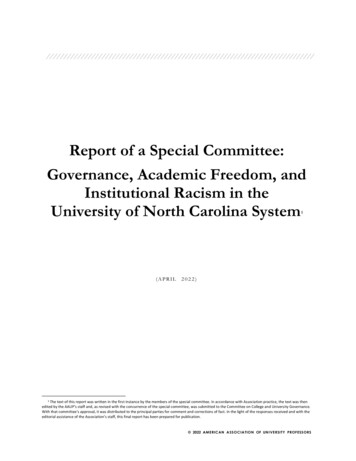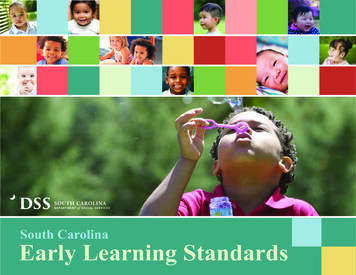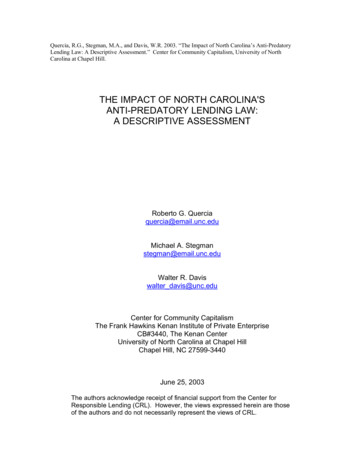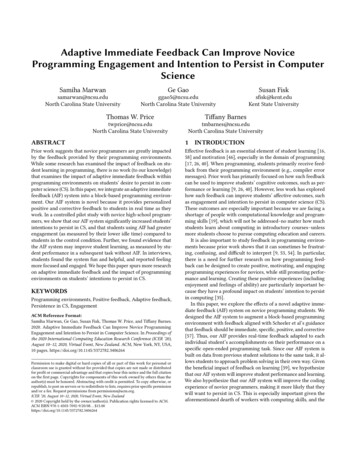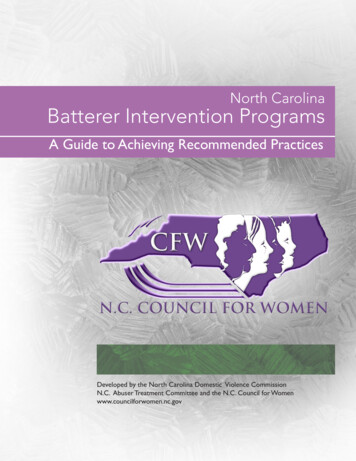
Transcription
North CarolinaBatterer Intervention ProgramsA Guide to Achieving Recommended PracticesDeveloped by the North Carolina Domestic Violence CommissionN.C. Abuser Treatment Committee and the N.C. Council for Womenwww.councilforwomen.nc.gov
Table of ContentsAcknowledgements3-4Introduction5Objectives and Purpose6Batterer Intervention Program Mission Statement and Philosophy7Fundamental Guiding Principles8Why Not Anger Management?Differences between Anger Managementand Batterer Intervention Programs9-11Administrative Guidelines for Batterer Intervention ProgramsAccountability and Safety12Batterer Intervention Program Rules and RecommendationsN.C. Administrative Code NCAC 17.0704-071813-30Topic-Related List of ResourcesA.B.C.D.E.F.G.H.I.J.K.Curriculum DiscussionCauses and Dynamics of Domestic ViolenceEffects of Domestic Violence on ChildrenPower and Control and Equality WheelVoluntary Enrollment and DSS ReferralsServing Diverse PopulationsWorking with Marginalized CommunitiesProcess for Investigating BIP ComplaintsGlossary of TermsSuggested Training ResourcesRecommended Memorandum of Developed by the North Carolina Domestic Violence CommissionAbuser Treatment Committee and the N.C. Council for Women2
AcknowledgmentsThe N.C. Domestic Violence Commission’s Batterer Intervention Committee hascreated this Guide to Achieving Recommended Practices to assist abuser treatmentservice providers with interpreting the rules as established by N.C. Administrative Code.Domestic violence survivors and citizens of North Carolina using this resource will alsoincrease their understanding of the purpose and intent of certified Batterer InterventionPrograms.Since 2002, when the N.C. Council for Women (CFW) received the authority to approveBatterer Intervention Programs (BIP) utilized by the North Carolina court system, over85 programs have received certification and thousands of individuals have benefitted.These programs serve a vital role: To re-educate domestic violence offenders on their behavior, and To help batterers develop new, healthier methods of interacting withintimate partners and family members.Thanks to members of the Abuser Treatment Committee for contributing content and toKathleen Balogh, CFW Region Director for coordinating production of the guidebook.The Council for Women will assist the Domestic Violence Commission and serviceproviders by periodically updating the online version of this guidebook. Visit our websitewww.councilforwomen.nc.gov for the latest updates.The Domestic Violence Commission assesses, examines and evaluates the causes,prevalence and prevention of domestic violence in North Carolina to assure thatnecessary services, policies, and programs are available. The Commissioncoordinates and collaborates with the N.C. Council for Women in strengthening existingdomestic violence and sexual assault programs and establishing new domestic violenceprograms. The Abuser Treatment Committee reviews and approves applications forcertification of N.C. Batterer Intervention programs on a semi-annual basis.The N.C. Council for Women is the leading voice on key issues impacting women andtheir families. The Council advises the Governor, the North Carolina legislature andstate agencies. The Council directs funds to serve domestic violence and sexualassault victims, coordinates production of the North Carolina Status of Women Report,and monitors grant programs that provide self-sufficiency for women in transition.3
How Language Is Used In This Guide 4We use male pronouns to refer to batterers and female pronouns to refer tothose who are battered, i.e. the victim. We use gender specific terms becausethe recommended curriculum is for men who batter and battering is not a genderneutral issue.Abuser, perpetrator, and batterer are used interchangeably when referring to theindividual committing domestic violence.Abuser Treatment and Batterer Intervention are used interchangeably.A Batterer Intervention Program is referred to as a BIP.
IntroductionBatterer Intervention Programs provide individual participants with the information theyneed in order to stop their abusive behavior. Approaches used in batterer programshold offenders solely responsible for their acts and prioritize victim safety in everyaspect of the program.Batterer Intervention Programs designed to stop domestic violence are based on acomplete understanding of the most effective strategies and are not to be confused withthe idea that a batterer may well need or want other services. Programs designed tostop battering begin with and continually focus on the thesis that “The vast majority ofmen who batter are not psychologically disturbed in the conventional sense Theirabuse is related to cultural, social, and political practices.” (Gondolf, 1985).Regardless of race, ethnicity, socioeconomic status, sexual orientation, religion, orphysical and mental abilities, domestic violence is a widespread problem that has direconsequences for women, families and communities. “Domestic Violence” is the termused to describe an extensive range of tactics used by men to control the lives ofwomen with whom they are or were partnered. Tactics include patterns of physical,sexual, economic, and psychological abuse resulting in an atmosphere of fear and/orterror for the victim.Domestic violence may result in death, permanent or other significant physical injuryand almost always causes serious psychological damage to the victims. A batterer’scontrolling and abusive tactics impact the primary victims as well as their children.Battering tends to escalate over time, increasing in frequency and severity. Dangerespecially escalates when the batterer perceives that his victim/partner may leavehim. Three-fourths of all domestic violence homicides against women and their childrenoccur once they leave the abuser.Domestic violence is a crime, and batterers must be held accountable for their abusivebehavior. It is the community’s responsibility to provide consequences by arresting,convicting, and punishing batterers for their criminal acts. BIP’s include communityprograms for batterer intervention and the N.C. Department of Corrections’ program forbatterers in prison, approved by the N.C. Council for Women.5
Objectives and PurposeThis guide is intended to: clarify state regulations, policies, operations, recommendations and services,and serve as a central resource for prospective service providers interested inbeginning a Batterer Intervention Program (BIP) in North Carolina.Rules regulating North Carolina BIPs are found in the North Carolina AdministrativeCode Title One – Administration Chapter 17 Council on the Status of Women Section.0700 – Abuser Treatment Programs. The rules are listed at the North Carolina Councilfor Women website www.councilforwomen.nc.gov and are included in this guide underthe section entitled: Administrative Guidelines for Batterer Intervention Programs.Batterer Intervention Programs not complying with North Carolina Abuser TreatmentProgram rules will not be certified by the N.C. Council for Women/Domestic ViolenceBIP Committee. The N.C. Council for Women recognizes that the field of battererintervention is evolving and will periodically convene experts to review and update theguidebook recommendations available on our website.The purpose of this guide is to provide: An understanding of BIP service provider’s responsibilities and services;Statewide communication and interaction among service providers andinterrelated agencies;Public information on guidelines and services of batterers’ programs;Criteria for program performance, efficacy, measurement, monitoring andprogram evaluation;Opportunities for data collection and research ;Support for batterer intervention service providers to collaborate with victimadvocates, share expertise, and seek common ground.The objectives of this guide are to promote and encourage: 6Consistency of operating practices in North Carolina,Safety of battered women;Accountability to victims, agencies, and the community;Knowledge of effective strategies for battering intervention;Offender accountability as a means to change behavior;Collaboration between stakeholders.
Batterer Intervention Program Mission Statement and PhilosophyIn 2009 the Domestic Violence Commission’s Abuser Treatment Committee adoptedthe following mission statement to frame the committee’s work and in North Carolinawith BIPs:“The mission of North Carolina Batterer Intervention Program (BIP) is to aid in theelimination of domestic violence by providing services to batterers, to hold themaccountable, promote safety and justice for victims and children, and to bring aboutsocial change necessary to end battering and all forms of domestic violence.”Program PhilosophyBatterer Intervention Programs:7 Maintain that domestic violence abusers are solely responsible for their actionsand reject the assumption that abuse occurs due to provocation or loss ofcontrol. Batterers carefully select the targets of their abuse, their partners, andchoose the circumstances of their violence, including the amount of injuryinflicted by their assaults, the location of those injuries, use of weapons, thepresence or absence of witnesses, and the quantum of terror accompanying theassaults. Recognize that abusers choose violence; they can also choose to stop violenceand eliminate coercive and controlling tactics in their intimate relationships. Educate men to consider the options for ceasing abusive behavior andembracing belief systems respectful of women. The decision to forsake violencerests exclusively with the batterer. Are committed to the safety of the victim and children, and will not jeopardize thepartner and children of those participating in their programs. Must develop a philosophical statement which articulates the intervention theoryof the program, and a philosophy that provides a clear picture of how groupleaders will conduct the intervention program.
Fundamental Guiding PrinciplesBelow are principles and a theoretical framework for education groups for batterers andintervention programs according to The Duluth Model:8 Domestic violence cuts across all lines of race, ethnicity, education, social class, sexualorientation, age, religion, geography, and physical or mental ability. Domestic violence is rooted in the institutionalized imbalance of power between men andwomen based on gender, in sex-role stereotyping, in gender-based values and inmisogyny. Most batterers’ use of violence is reflective of a belief system based on thewidespread assumption that men are entitled to impose their will on their partners. Men who batter believe themselves ‘entitled’ to the use of abuse with intimate partners.The widespread epidemic of domestic violence is not the result from individual personalor moral deficits, diseases, diminished intellect, addiction, mental illness or otherexternal persons or events. Violence is a learned and chosen behavior and therefore it can be changed. New waysof participating in intimate relationships can be implemented. Domestic violence is illegal. Other forms of abuse are morally wrong. Family andcriminal courts have sanctions available to stop domestic and intimate partner violence.Men who batter need to be held accountable for their choices. Women and childrenmust be protected. Intervention programs for men who batter are NOT to be used as a substitute or a wayto circumvent arrest, incarceration, or other legal sanctions; nor should they be used asa mitigated legal consequence. Abuse will likely increase in frequency and severity when the batterer thinks that hispartner may be leaving, or when she is leaving, or when she has actually left therelationship. These times may actually be the most dangerous time for the batteredwoman. The safety and rights of the victim must be respected at all times. The victim has a rightto live free of violence and that right supersedes other considerations. The victim’sfeelings, as well as the potential for further harm should always be of utmostconsideration when making policy/program decisions. Intervention with men who batter may give the partner a false sense of security and mayserve as a substantial disincentive to separation and other safety planning. Serviceproviders must implement Intervention education with particular care to safeguard thevictim and the children. Batterer intervention requires cooperated community response with the domesticviolence agency, law enforcement, the judicial and probation to system.
Why Not Anger Management?BIP education content which focuses on anger and the development of angermanagement skills is inappropriate and does not meet the approved curriculum for N.C.certification. Anger management does not challenge or explain the value systemsupporting domination and violence and creates the erroneous assumption that loss ofemotional control is the cause of domestic abuse. The anger management model failsto explain or confront the batterer’s selective targeting of abuse and may serve toincrease the batterer’s skills in nonphysical control over others. Some stress or angermanagement techniques may be presented as long as it is emphasized that anger orother emotions are not at the root of battering. Anger is used as a controlling techniquewhich, if ineffective, escalates into violence. Learning to reduce stress and manageanger does not necessarily reduce a batterer’s belief that domination of a partner is notappropriate.Treatment of domestic violence offense employs a variety of theories, modalities, andtechniques. Court ordered domestic violence offenders are a separate category ofviolent offenders requiring a specialized approach.Domestic violence offenders tend to exhibit behavior that is covert, deceptive, andsecretive. These behaviors are often present long before they are recognizedpublicly. Domestic violence behavior is dangerous and when domestic violence occurs,there is always a victim. Abusers may deny and minimize the facts, severity, andfrequency of their offenses. Domestic violence abusers often maintain a sociallyacceptable guise to hide their abusive behaviors. At its extreme, domestic violencebehavior can result in the death of the victim, offender, family members, and others.Anger Management programs teach strategies to recognize anger and provide healthy,constructive avenues for the expression and management of anger. The overallobjective of this type of program is to diffuse future anti-social behavior on the part ofclients by teaching them to recognize and deal with anger in healthy ways.The following listing includes requirements of BIP’s that are distinct from AngerManagement programs or private therapies: 9Court ordered domestic violence offenders receive treatment from providerscertified by the North Carolina Council for Women.Individual treatment goals that reduce recidivism and increase victim andcommunity safety.BIP’s consult and communicate with the domestic violence agency, victimadvocates, and other involved agencies.Victims have confidentiality but abuser confidentiality is limited by the criminaljustice system requirements and needs for victim safety.Victim advocacy is an essential component of batterer intervention.Treatment involves challenging the abusers’ perceptions and beliefs.
Differences between Anger Management Programs and Approved BIP’sQuestionsAre programsstate certified?Who is servedby theprograms?How long areprograms?Do programscontactvictims?Are programsmonitored by astate agency?Are programslinked with aDomesticViolenceagency?Do programsassessbatterers forlethality?AngerManagementProgramsNoPerpetrators ofstranger or nonintimateviolenceUsually 6 - 20sessions, withthe averageprogram lasting10 sessionsNoNoNoYes. State approval of programs is granted andmonitored by the Council for WomenSpecifically designed to work with intimatepartner violence and domestic violence offendersA required minimum of 26 weeksYes. Victim confidentiality is maintained howeverif the victim chooses, the program will remain inregular contact with her/him to provide referrals,updates, and safety planning. .Yes. By the N.C. Council for Women and theDomestic Violence Commission/BIP CommitteeYes. Each approved provider must have alinkage with a domestic violence agency and acurrent Memorandum of Understanding*Yes. While not a perfect prediction model,approved BIPs’ perform risk and other forms ofassessment and evaluation. The intakeevaluation explores many sources of informationsuch a criminal history See the Resource Section for a sample of a Memorandum of Understanding10NoN. C. Approved Batterer InterventionPrograms
Anger ManagementApproved BIPWhat is theemphasis oftheintervention?Violence is seenas a momentaryoutburst ofanger, soperpetrators aretaught to usetechniques like“time outs”Are groupfacilitatorstrained in DV?Subject toagencydiscretionPhysical violence is seen as one of many formsof abusive behaviors chosen by batterers tocontrol their intimate partners, including physical,sexual, verbal, emotional, and economicabuse. Domestic violence offender treatmentholds batterers accountable for the violent andabusive choices they make. They teachbatterers to recognize how their abuse affectstheir partners and children. Batterers learnalternatives to abusive behaviorsState standards specify specialized trainingdepending on job descriptions. Continuingeducation hours are required each year.How would Iaddressgrievanceswith this typeof program?What type ofdata collectionoccurs?Talk to thedirector of theprogramTalk to the director of the program or call theCouncil for Women ( 919-733-2455 or 1-828-2516169)No statewidesystemThe Council for Women utilizes a quarterlystatistical reporting form. Yearly statistics areavailable to the public on the website,www.councilforwomen.nc.gov11
Administrative Guidelines for Batterer Intervention ProgramsA BIP may be administrated by an individual or an agency, private-for-profit, not-forprofit, government or a domestic violence agency. In their applications, the BIP mustdemonstrate adequate administrative capabilities to operate a batterers program.The BIP’s are strongly encouraged to develop a policy and procedures Guide thataddresses all areas of the North Carolina Administrative Code, Title One, Chapter 17,Section .0700, and present at time of application for program approval.Developing and monitoring staff members adherence to administrative procedures listedbelow is good practice.AccountabilityDue to safety concerns, BIP’s hold their clients and staff accountable and conduct staffbackground checks and drug/alcohol screenings. The programs will adopt a Code ofEthics. The Code of Ethics includes a policy that addresses any staff that commits anact of abuse in their personal relationships.Routine evaluations that track client completion rates, recidivism and terminationsinsure greater client accountability and program effectiveness.SafetyVictim safety and the safety of their children take precedence over all other programobjectives and acknowledged in all services, policies and procedures.BIP’s must acknowledge in all services, policies, and procedures, that the safety ofvictims and their children is of primary importance and takes precedence over all otherprogram objectives.Staff will establish and maintain cooperative working relationships with local domesticviolence programs, domestic violence task forces, victims of violence, and the DVCommission.12
Batterer Intervention Program Rules and RecommendationsEach of the following sections begins with a recitation of the N.C. Administrative Code(The rule language is in italics)Intake and Assessment NCAC 17.0704:(a) All abuser treatment programs shall establish and comply with written policiesand procedures regarding abuser intake and assessment.(b) Intake: A comprehensive intake and assessment shall be administered to allparticipants. The intake shall include:(1) Family and social history;(2) Medical health history;(3) Relationship history;(4) History of violent, abusive, and controlling behavior;(5) History of past criminal behavior;(6) Substance abuse history and screening;(7) Assessment of participant’s cognitive or social skills(8) Any other factors that might interfere with the participation in a groupprogram; and(9) Lethality assessment(c) Lethality Assessment: Because of the severity of injuries and the number ofdeaths caused by domestic violence, lethality assessment shall be ongoing andnot limited to intake. A lethality assessment shall include the following indicatorsof increased lethality risk:(1) violence that increases in severity, frequency, and specificity;(2) a high degree of ownership that the abuser expresses regarding thevictim(3) violation of court orders and conditions of probation;(4) change in access to and relationship with victim;(5) accessibility to weapons, especially firearms;(6) life stressors (e.g., divorce, chronic illness, death of loved one, andunemployment);(7) frequent or severe intoxication from alcohol or other drugs;(8) threatened or attempted homicide or suicide;(9) stalking behavior;(10) history of holding victim captive;(11)pet abuse;(12)victim making plans to leave or has already left;(13)extreme isolation of the victim;(14)increased level of risk-taking by the abuser;(15) history of sexual abuse(16)(17)acute mental health problems, including depression and anti-socialbehavior;(18)past use of weapons or objects;13
(19)strangulation behaviors; and(20)violence in the family of origin.(d) Abuser treatment programs shall also provide initial and ongoing referral servicesfor participants who have concurrent substance abuse, medical, or mental healthproblems.Client Referrals and IntakeReferrals to the BIP come from a variety of sources including; Civil and Criminal Courts,Probation and Parole, Department of Social Services, Mental Health or SubstanceAbuse programs, self-referral or voluntary.The purpose of the intake and assessment is not to determine if an individual is abatterer, but to determine the lethality of the batterer’s actions, or how dangerous theclient may be to his victim and children. The assessment is to determine theappropriateness for admission to the program. The N.C. Council for Womenrecommends the BIP not accept referrals where the assessor is asked to determine ifthe client is a domestic violence abuser.During intake, the worker compiles a complete history of the violence, sexual assaults,and psychological abuse that the client admits to toward his current partner, the victimhe assaulted in the arrest incident (where applicable), and any past partners, children orfamily pets. These admissions need to be carefully documented.The intake process provides an opportunity for the client to discuss his history ofviolence in a one-to-one context with the assessor. Offenders may need additionalservices for mental health/ psychiatric assistance, drug and alcohol treatment, parentingeducation, or other issues. Batterers should be screened for these issues and referredto appropriate resources but these treatments are in addition to, not in lieu of, a battererintervention program.The intake process includes an orientation to the agency, staff, program rules and theparticipation contract. (See Program Structure for more information on orientation)It is essential the BIP obtain the client’s criminal record at intake. The offender providesall copies of pertinent papers and forms. If the client has been arrested, he provides thearrest report from the most recent incident, and from the incident that led to programreferral if that is different.The offender should not be the sole source of information on his case history. Acomplete assessment includes statements from the DSS caseworker and the victim,warrants, probation, law enforcement reports, and criminal history.14
Lethality AssessmentLethality assessment is an ongoing process throughout the 26 week BIP process, and isconducted during intake, mid- way through the program, and upon completion.Lethality assessment forms are not completed by the client alone, nor should providersdepend on a simple check-the-box format or yes-no responses.Important FactorsWhen conducting the lethality assessment always take the following list of importantfactors seriously: 15The victim has a strong “gut” sense that the man could kill her or her children,carry out a serious and dangerous assault against any of them or againsthimself.She is taking steps to end the relationship, or has already done so.He has exhibited extreme behaviors when his current partner or past partnershave made attempts to leave him.He is extremely jealous and possessive. He is obsessive, she is constantly at thecenter of his thoughts and he is unable to conceive of life without her. He has, forexample, made statements such as, “If I can’t have you, nobody will.”He follows her, monitors her whereabouts, uses high-tech means to keep tabs onher, or stalks her. He knows where she lives and works, knows names andaddresses of her friends or relatives, or very familiar with her daily routines.He has a history of severe or very frequent violence toward her, or toward otherindividuals such as past partners. He was violent to her during a pregnancy.He threatens to kill her or to hurt her severely, has strangled her, or threatenedher with a weapon (including making verbal reference to using a weapon, even ifhe did not actually brandish it).He threatened to kill the children, stepchildren or the whole family. He is violentwith the children and/or he killed or has been violent to pets.He is depressed, suicidal, or shows signs of not caring what happens to him. Hehas, for example, threatened to kill himself if she leaves him.He is not close to anyone, has no current relationships with friends or relativesand/or he is unemployed.He has a significant criminal history and/or a history of using violence orthreatening violence against other people. He has access to weapons and isfamiliar with their use.He abuses alcohol or drugs heavily, especially if his habits involve daily or nearlydaily intoxication.He uses pornography heavily and has a history of perpetrating sexual violence ordegradation against his partner or others.
When a client appears particularly dangerous, based upon the above factors, theprofessionals working with him should inform the victim as soon as possible. It isstrongly recommended that staff inform appropriate police departments, mental healthor child protection professionals involved with the client, and anyone who might be in aposition to prevent a dangerous assault from taking place.Victim Safety NCAC 17.0705All BIP’s shall establish and comply with written policies and procedures regardingvictim safety. These policies and procedures shall include the following:(1)The program shall make good faith attempts, which shall be documented,to make contact with the victim upon the participant’s enrollment in theprogram. This contact must include information about the program and itslimitations, victim confidentiality, and local resources for victims. Theprogram shall attempt, in collaboration with the victim service agency, tocontact the victim when the program participant has completed half of thesessions, and at termination, unless the victim declines contact or isunable to be located.(2)Program participants and person who have been victimized by thoseparticipants may receive direct services from the same agency. In thoseinstances, the same staff person or volunteer shall not provide services toboth parties.(3)All information about or from the victim shall be kept confidential from theprogram participant, except with written permission from the victim.(4)The program shall not schedule victims’ groups and Batterers Interventiongroups to occur simultaneously at the same facility.(5)The BIP shall network with its local victim services program and have acurrent memorandum of understanding regarding cooperation with thatprogram in place.Whenever possible, BIP staff contacts the victim with a face-to-face interview. Duringthe interview BIP staff provides information about the purpose of the program, theprocedure for reporting further offenses, a preliminary assessment for the victim’s ownuse in determining risk, limitations of the program, resource information regarding victimservices and opportunity for the victim to provide input in the assessment process.Phone and mail contact can be used after assessing victim safety, or if the victim doesnot permit a face to face interview.BIP staff view their responsibility to victims as equal to their responsibility to offenders(clients). The following are general guidelines managing partner contact:16 Staff is trained to understand they have a duty to warn and protect victims,partners, children and others the client may have threatened. Ensure telephones, mail and other communication is secure as possible againstintrusion by the participant or others.
Tell the partner about her right to confidentiality. She may consent to discloseher report but caution her to do so only if she has a safety plan and believesdisclosure will not affect her safety. Inform the partner that no one can guarantee her safety nor guarantee thatdisclosure of her information will not result in a violent reaction by the client. Notify the partner that her option to provide a witness statement or a complaint tothe legal system is not confidential or anonymous. She may receive someinformation regarding the time and method a participant is confronted. Advise the partner, before she provides any information involving suspected childabuse and/or neglect, or abuse of elder adults, cannot be confidential and will bereported to the legal system. Carefully document, in writing, the partner’s wishes regarding the use of theinfo
3 Acknowledgments The N.C. Domestic Violence Commission's Batterer Intervention Committee has created this Guide to Achieving Recommended Practices to assist abuser treatment service providers with interpreting the rules as established by N.C. Administrative Code.
